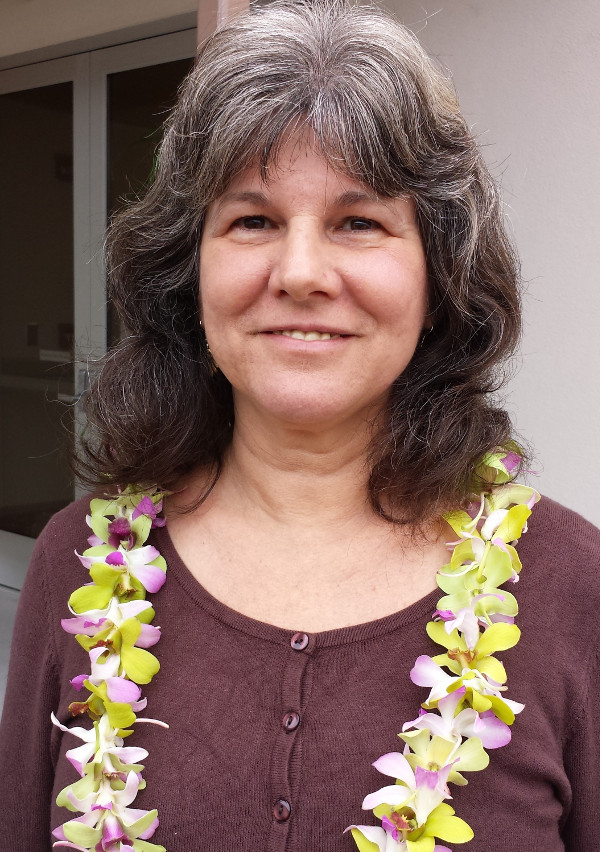| Marisa Wall |

|
Contact InformationUSDA-ARS
|
|
Publications
via ARIS System
Education
- B.S. Horticulture, Pennsylvania State University, 1982
- M.S., Horticulture, University of Maryland, 1986
- Ph.D., Horticulture, University of Maryland, 1989
Academic Positions
- 1984-1989, Research Assistant, University of Maryland, College Park, MD
- 1990-1996, Assistant Professor, Dept. Agronomy and Horticulture, New Mexico State University, Las Cruces, NM
- 1996-2000, Associate Professor, Dept. Agronomy and Horticulture, New Mexico State University, Las Cruces, NM
- 1998, Visiting Professor, Dept. Molecular Plant Physiology, University of Hawaii at Manoa, Honolulu, HI
- 2001, Professor, Dept. Agronomy and Horticulture, New Mexico State University, Las Cruces, NM
- 2001-2014, Research Food Technologist, USDA-ARS, U.S. Pacific Basin Agricultural Research Center, Hilo, HI
- 2014-present, Center Director, Supervisory Research Horticulturist, USDA-ARS, Daniel K. Inouye U.S. Pacific Basin Agricultural Research Center, Hilo, HI
Research Accomplishments
I have been leading research programs in the areas of postharvest physiology, vegetable breeding, and crop production for over 26 years. My areas of expertise include postharvest physiology of horticultural crops, biochemical quality analyses, and quarantine treatment of fresh commodities. Prior to joining ARS, I was Professor of Horticulture at New Mexico State University where I initiated the first programs in sweet onion breeding and postharvest physiology, with supporting teaching and extension activities. My current research is focused on postharvest physiology, quarantine treatment and export, and food technology for tropical crops, but my unique interdisciplinary experience enables me to lead research programs that encompass an entire production and postharvest system, from the seed to the consumer.
Quality of tropical crops following irradiation treatment
Irradiation can be used as a postharvest treatment to control quarantine insect pests for export of fresh fruit and vegetables to markets where they command premium prices. The economic viability of irradiation as a quarantine treatment improves if a diversity of crops can be treated. My research is focused on defining the radiotolerance limits for high-value, tropical crops, and mixtures of tropical fruit. I have determined the compositional, sensory and storage quality of these crops following quarantine irradiation treatment, and elucidated the preharvest and physiological conditions that impact radiotolerance. The research supports the USDA-APHIS regulations allowing for export of fresh commodities following quarantine irradiation treatment and has greatly expanded exports. Hawaii's specialty crop exporters confidently irradiate and market over 20 million pounds annually. 

Macadamia nut biochemistry and processing quality
Three major quality defects of macadamia nuts are gray kernel disorder, internal browning after roasting, and off-flavor development (oxidation and rancidity) during storage. My research has defined the biochemical and physical factors that contribute to kernel browning and oxidation, and established the preharvest and processing conditions under which these disorders manifest. Our lab quantified the phytochemicals, tocotrienols and squalene, in several cultivars of macadamia nuts grown in three microclimates, and identified cultivars with superior oxidative stability, enabling longer term storage. We also proved that a bacteria (Enterobacter cloacae) causes gray kernel disorder and established the environmental conditions optimal for disease development. My research provided the first understanding of the impact of initial kernel composition on post-processing quality, and demonstrated the importance of well-controlled processing conditions on macadamia kernel quality. The results have been used by the macadamia industry to optimize harvest and processing steps to enhance quality.


Tropical fruit nutritional composition
Following the decline of sugarcane, Hawaii's agricultural base shifted to diversified small farms producing exotic tropical crops. New specialty fruit orchards are being planted annually and market supply is expected to increase greatly as trees reach full production. My research established precise compositional analyses for cultivars of five tropical fruits (banana, papaya, lychee, longan, and rambutan) grown in different micro-climates and soil types. The analyses were the most specific and sensitive determination of vitamin and mineral concentrations to date for tropical fruit. The fruit composition data is used to market these exotic fruit and to evaluate diets for nutritional adequacy.



Postharvest practices to improve tropical fruit quality
Postharvest practices to manage diseases, improve fruit quality, and extend the shelf-life of longans and rambutans were identified. The most suitable packaging systems were established for maintaining postharvest quality under optimum temperatures, as well as under fluctuating temperature regimes commonly experienced during the postharvest chain.In related research, we are investigating modified atmosphere packaging of fresh papaya for potential marine shipment to export markets.Adoption of a better packaging system for specialty fruit does not require a change in field practices, but can reduce postharvest quality problems which have been major constraints during export and marketing.
Honors, Awards, Achievements and Recognition:
- Certified Food Technologist, Institute of Food Technologists
- Federal Laboratory Consortium Award for Excellence in Technology Transfer, 2010, for implementation of phytosanitary irradiation treatment protocols for tropical fruit
- Best Poster Award, 2007, Australasian Postharvest Conference, Terrigal, Australia
- Outstanding Contribution Award, 2001, New Mexico Chile Pepper Task Force
- Distinguished Research Award, 1998, College of Agriculture and Home Economics, New Mexico State University
- Honorary State FFA Degree, New Mexico, 1997
- Northeast Region Research Paper Award, 1989, American Society for Horticultural Science
- Leland E. and Catherine B. Scott Award, 1987, Excellence in Graduate Study Award, Department of Horticulture, University of Maryland

